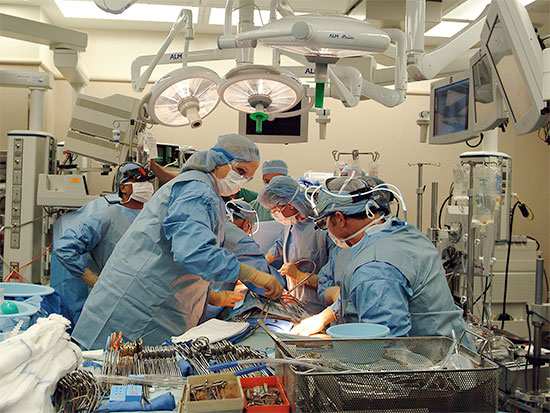 Mowing the yard is not a chore for John Williams. Not anymore. In fact, cutting his 4-plus acres near Dora, Alabama, is kind of a treat for the retired coal miner.
Mowing the yard is not a chore for John Williams. Not anymore. In fact, cutting his 4-plus acres near Dora, Alabama, is kind of a treat for the retired coal miner.
Not long ago, he could barely move.
A fall in the coal mine in 2008 left Williams with severe pain in his back. He had to stop working in 2010; the pain made even walking difficult. He was miserable, falling into depression, and he could not sleep. His only recourse was a prescription for strong opioid-based pain medications.
“I’m not much on taking pills,” Williams said. “And the pills didn’t heal anything; they just covered up the pain. But it always came back.”
Williams was ultimately referred to University of Alabama at Birmingham neurosurgeon M.R. Chambers, DVM, M.D., who determined Williams was a candidate for a laminectomy, a type of back surgery that relieves pressure on spinal nerves and can ease pain.
Chambers is an associate professor in the Department of Neurosurgery in the School of Medicine, and UAB’s principal investigator of the Quality Outcomes Database. The QOD is a national database of surgical outcomes. UAB is one of 87 surgical practices and hospitals that voluntarily submit their outcomes data to the registry.
Lumbar, or lower-back, surgery outcomes is one of the major reporting categories in the QOD.
In the most recent report, UAB neurosurgeons beat national averages in three significant measures: overall patient satisfaction, return to work within three months and readmission to the hospital within 30 days.
| In the most recent report, UAB neurosurgeons beat national averages in three significant measures: overall patient satisfaction, return to work within three months and readmission to the hospital within 30 days. |
“We pay close attention to these three measures because we believe they best represent the immediate goals of our patients,” Chambers said. “Patient outcomes are our best measures of success. We feel the best way to continue to provide excellent care is to monitor and improve our outcomes.”
The QOD report showed that UAB’s patient satisfaction score — meaning the surgery met expectations — was 72 percent, higher than the national average of 66 percent. UAB’s return to work in three months score stood at 89 percent against a national figure of 78 percent, and UAB’s readmission rate within 30 days was only 1.2 percent, while the national average was more than twice that at 3.7 percent.
Those numbers do not surprise John Williams.
“Dr. Chambers performed surgery on me in 2015, and I couldn’t be happier with the results,” Williams said. “She took the time to understand what I was dealing with, and planned a strategy that would help me get what I wanted in terms of recovery. Now I can get out and mow the lawn and do just about anything I want to do.”
| The database helps to create benchmarks, establish best practices, and identify the most appropriate procedures or approaches for groups of patients who share similar injury patterns or demographics. |
Chambers says the purposes of voluntarily reporting data to QOD are to track the quality of care and to track outcomes so that surgeons have the latest data available. That allows them to help patients make informed choices for their care. The database helps to create benchmarks, establish best practices, and identify the most appropriate procedures or approaches for groups of patients who share similar injury patterns or demographics.
“There is a precision medicine component here, allowing us to drill down through all this data to determine which therapies or procedures will be most likely to provide the best results for each group of patients,” Chambers said. “For example, we can easily see which procedures were most effective for patients over a certain age with a certain diagnosis.”
For Williams, the laminectomy was the right choice. The pain is gone, and his quality of life is greatly improved. He says knowing that his surgeon took patient satisfaction outcomes seriously was a big boost to his confidence going into the procedure.
The QOD is supported by the American Association of Neurological Surgeons, the Neurosurgery Research and Education Foundation, the Congress of Neurological Surgeons, the American Board of Neurological Surgery, the Society of Neurological Surgeons, and the AANS/CNS Joint Section on Spine and Peripheral Nerves.